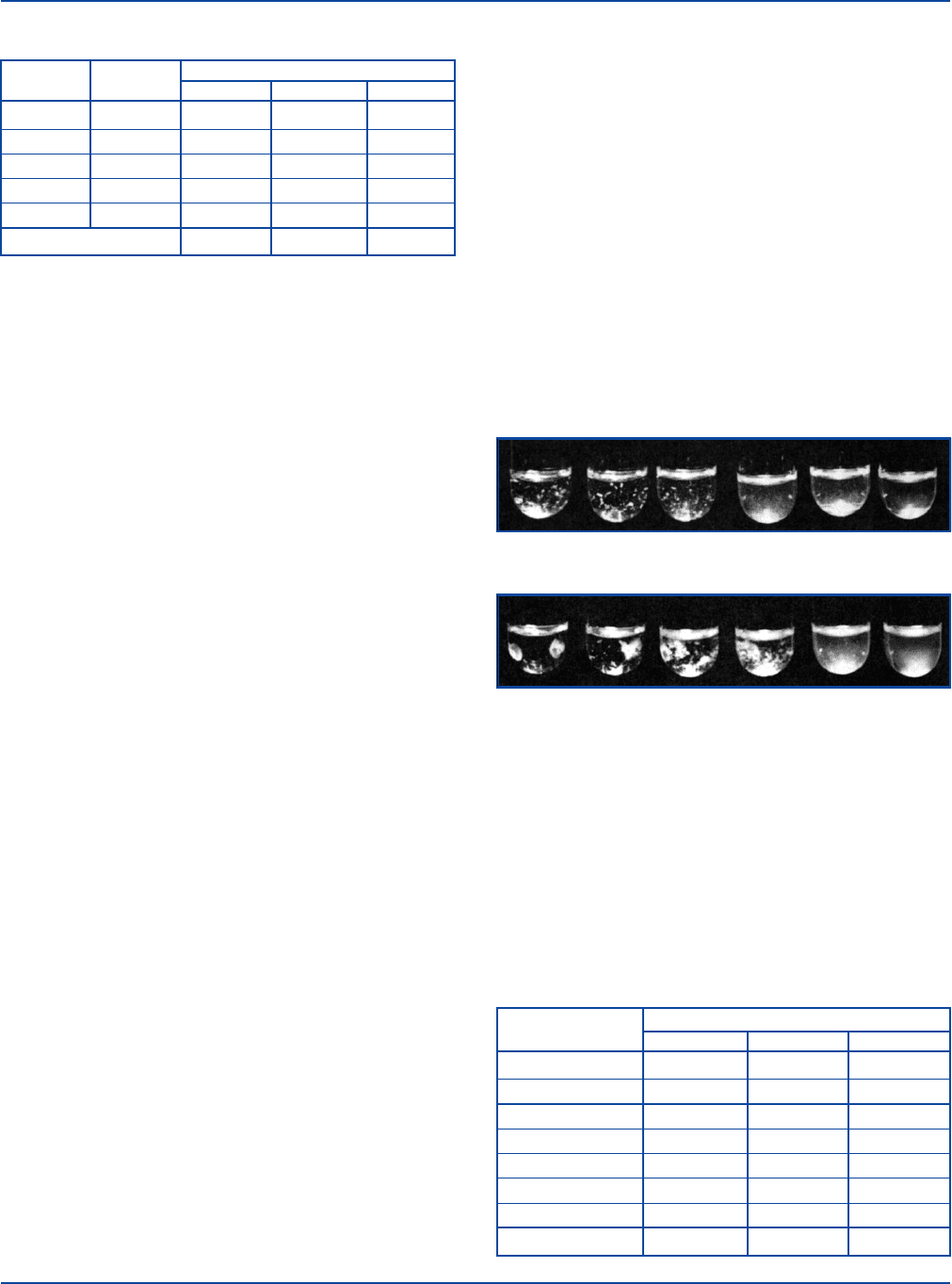BD Diagnostic Systems (publ.). Difco Manual (Manual of Microbiological Culture)
Подождите немного. Документ загружается.


640 The Difco Manual
Table 1. Sample Rapid Slide Test reactions.
CORRELATED
REACTIONS
SERUM (ml) TUBE DILUTION SPECIMEN 1 SPECIMEN 2 SPECIMEN 3
0.08 1:20 3+ 4+ 4+
0.04 1:40 2+ 4+ 3+
0.02 1:80 1+ 3+ 2+
0.01 1:160 – 3+ +
0.005 1:320 – 1+ –
Serum titer 1:40 1:160 1:80
Tube Test
Salmonella O Antigen Group D and Salmonella H Antigens a, b and d
in the Febrile Antigen Set are used for both slide and tube agglutina-
tion tests. Brucella Abortus Antigen (Slide) and Proteus OX19 Antigen
(Slide) are intended only for slide tests. When confirmation of the slide
test and quantitation is required, separate tube test antigens, Brucella
Abortus Antigen (Tube) and Proteus OX19 (Tube), may be purchased
separately.
Each Febrile Antigen must be tested separately. Repeat steps 1-10 for
each antigen.
Prepare a 1:20 dilution of each antigen to be tested by adding 1 part of
antigen to 19 parts of sterile NaCl solution.
1. Prepare a row of 8 culture tubes (12 x 75 ml) for each test serum,
including a row for the Febrile Positive Control Polyvalent.
2. 0.85% NaCl solution: Dispense 0.9 ml in the first tube of each
row and 0.5 ml in the remaining tubes.
3. Test serum: Using a 1 ml serological pipette, dispense 0.1 ml of
test serum in the first tube in the row and mix thoroughly. Transfer
0.5 ml from tube 1 to tube 2 and mix thoroughly. Similarly, continue
transferring 0.5 ml through tube 7, discarding 0.5 ml from tube 7
after mixing. Tube 8 is the antigen control tube and contains only
sterile 0.85% NaCl solution.
4. Positive control: Using a 1 ml serological pipette, dispense 0.1 ml
of Febrile Positive Control Polyvalent in the first tube in the row
and mix thoroughly. Transfer 0.5 ml from tube 1 to tube 2 and mix
thoroughly. Similarly, continue transferring 0.5 ml through tube 7,
discarding 0.5 ml from tube 7 after mixing. Tube 8 is the antigen
control tube and contains only sterile 0.85% NaCl solution.
5. Febrile Antigen: Add 0.5 ml of the diluted antigen suspension to
all 8 tubes in each row and shake the rack to mix.
6. The final dilutions in tubes 1-7 are 1:20, 1:40, 1:80, 1:160, 1:320,
1:640 and 1:1280, respectively.
7. Incubate as specified (eg., in a waterbath or refrigerator):
Brucella Abortus Antigen: 35-37°C for 48 ± 3 hours.
Proteus OX19 Antigen: 35-37°C for 2 hours, then at
2-8°C for 22 ± 2 hours.
Salmonella O Antigen Group D: 50 ± 2°C for 17 ± 1 hours.
Salmonella H Antigens a: 50 ± 2°C for 1 hour.
Salmonella H Antigens b: 50 ± 2°C for 1 hour.
Salmonella H Antigens d: 50 ± 2°C for 1 hour.
8. Remove from incubation. Avoid excessive shaking before reading
the reactions, either when the tubes are incubating or when
removing them from incubation.
9. Read and record results.
Results
1. Read and record results as follows.
4+ 100% agglutination; background is clear to slightly hazy.
3+ 75% agglutination; background is slightly cloudy.
2+ 50% agglutination; background is moderately cloudy.
1+ 25% agglutination; background is cloudy.
– No agglutination.
2. Salmonella Antigens used in tube agglutination procedures detect
antibodies to either O (somatic) antigens or H (flagellar) antigens
and these antibodies give different reactions. An O antigen and the
corresponding antibody give a coarse, compact agglutination that
may be difficult to disperse. An H antigen and its corresponding
antibody give a loose flocculent agglutination. Do not vigorously
shake tubes containing H antigens. Characteristic O and H aggluti-
nation is illustrated below.
Somatic “O” Agglutination
Flagellar “H” Agglutination
3. Positive control: Should show a 2+ or greater agglutination at the
following dilutions:
Brucella Abortus Antigen 1:80
Proteus OX19 Antigen 1:160
Salmonella O Antigen Group D 1:80
Salmonella H Antigens a, b and d 1:80
4. Antigen control: Tube 8 of each row should show no agglutination.
5. Test serum: The serum titer is that dilution which shows a 2+ or
greater agglutination. See Table 2.
Table 2. Sample Macroscopic Tube Test reactions.
REACTIONS
SERUM DILUTION SPECIMEN 1 SPECIMEN 2 SPECIMEN 3
1:20 4+ 3+ 4+
1:40 4+ 2+ 4+
1:80 3+ 1+ 4+
1:160 2+ – 4+
1:320 1+ – 3+
1:640 – – 2+
1:1280 – – 1+
Serum titer 1:160 1:40 1:640
Febrile Antigen Set Section V

The Difco Manual 641
Interpretation
1. Compare results:
DISEASE ASSOCIATED FEBRILE ANTIGEN SIGNIFICANT TITER
Brucellosis Brucella Abortus 1:160
Rocky Mountain
spotted fever* Proteus OX19 1:160
Typhus* Proteus OX19 1:160
Typhoid fever Salmonella O Antigen Group D** 1:80
Typhoid fever Salmonella H Antigen d** 1:80
Paratyphoid fever Salmonella H Antigen a** 1:80
Paratyphoid fever Salmonella H Antigen b** 1:80
* Rocky Mountain spotted fever cannot be differentiated from typhus by this test.
** Antibodies produced in response to other Salmonella species can cross-react.
2. Single serum specimen: A significant titer suggests infection.
3. Pair of serum specimens (acute and convalescent): A two-dilution
increase in titer is significant and suggests infection. A one-dilution
difference is within the limits of laboratory error.
4. Positive control and antigen control: If results are not as described,
the test is invalid and results cannot be reported.
Limitations of the Procedure
1. The slide test is intended for screening only and should be confirmed
by the tube test. Slide test dilutions are made to detect a prozone
reaction and do not represent true quantitation of the antibody. A
serum specimen with a prozone reaction shows no agglutination
because of excessively high antibody concentrations. To avoid this
occurrence, all 5 serum dilutions in the slide test should be run.
2. Detection of antibodies in serum specimens may complete the
clinical picture of a patient having an infection. However, isolation
of the causative agent from patient specimens may be required. A
definitive diagnosis must be made by a physician based on
patient history, physical examination and data from all labora-
tory tests.
3. Cross-reacting heterologous antibodies are responsible for many
low-titer reactions. Infections with other organisms, vaccinations
and history of disease may result in a low level of antibody titer.
Antimicrobial therapy may suppress antibody production.
Cross reactions between antigens and antibodies of B. abortus and
F. tularensis, Y. enterocolitica or V. cholerae can occur.
Rocky Mountain spotted fever and typhus cannot be differentiated by
this test because species of Rickettsia cause cross-reacting antibodies.
Infections with Proteus species can cause cross-reacting antibodies.
Cross-reactions between antigens and antibodies of various
Salmonella species can occur.
Previous immunizations with typhoid vaccine or previous infection
with Salmonella species sharing common antigens with S. typhi
can cause elevated antibody titers for prolonged periods. Other
non-typhoid febrile illnesses may cause elevation of cross-reacting
antibodies.
4. While a single serum specimen showing a significant titer suggests
infection, it is not diagnostic.
5. To test for a significant rise in antibody titer, at least two specimens
are necessary: an acute specimen, obtained at the time of initial
symptoms, and a convalescent specimen, obtained 7 to 14 days
later. A two-dilution difference in the titers is a significant increase
in antibody level and suggests infection.
6. Prolonged exposure of reagents to temperatures other than those
specified is detrimental to the products.
7. Exposure to temperatures below 2°C can cause autoagglutination.
Antigens must be smooth, uniform suspensions; before use, examine
antigen vials for agglutination. Suspensions with agglutination are
not usable and should be discarded.
8. Discard rehydrated Febrile Positive Control Polyvalent or Febrile
Negative Control that is cloudy or has a precipitate anytime during
its period of use.
References
1. Widal, F. 1896. Serodiagnostic de la fièvre typhoide. Sem. Med.
16:259.
2. Spink, W. W., N. D. McCullough, L. M. Hutchings, and
C. K. Mingle. 1954. A standardized antigen for agglutination
technique for human brucellosis. Report no. 3 of the National
Research Council, Committee on Public Health Aspects of
Brucellosis. Am. J. Pathol. 24:496-498.
3. Weil, E., and A. Felix. 1916. Zur serologischen Diagnosis des
Fleckfiebers. Wien. Klin. Wochenschr. 29:33-35.
4. Miller, L. E., H. R. Ludke, J. E. Peacock, and R. H. Tomar.
1991. Manual of laboratory immunology, 2nd ed. Lea & Febiger.
5. Rose, N. R., H. Friedman, and J. L. Fahey (eds.). 1986. Manual
of clinical laboratory immunology, 3rd ed. American Society for
Microbiology, Washington, D. C.
6. Turgeon, M. L. 1990. Immunology and serology in laboratory
medicine. The C. V. Mosby Company, St. Louis, MO.
7. Sack, R. B., and D. A. Sack. 1992. Immunologic methods for the
diagnosis of infections by Enterobacteriaceae and Vibrionaceae,
p. 482-488. In N. R. Rose, E. C. De Macario, J. L. Fahey, H.
Friedman, and G. M. Penn (eds.), Manual of clinical laboratory
immunology, 4th ed. American Society for Microbiology,
Washington, D. C.
8. Centers for Disease Control. 1988. Update: universal precautions
for prevention of transmission of human immunodeficiency virus,
hepatitis B virus, and other bloodborne pathogens in health-care
settings. Morbidity and Mortality Weekly Reports 37:377-382,
387-388.
9. Occupational Safety and Health Administration, U.S.
Department of Labor. 1991. 29 CFR, part 1910. Occupational
exposure to bloodborne pathogens; final rule. Federal Register
56:64175-64182.
10. Pezzlo, M. 1992. Aerobic bacteriology, p. 1.0.1-1.20.47. In
H. D. Isenberg (ed.), Clinical microbiology procedures handbook,
vol. 1. American Society for Microbiology, Washington, D.C.
11. Miller, J. M., and H. T. Holmes. 1995. Specimen collection,
transport and storage. In P. R. Murray, E. J. Baron, M. A. Pfaller,
F. C. Tenover, and R. H. Yolken (ed.), Manual of clinical
microbiology, 6th ed. American Society for Microbiology,
Washington, D.C.
Section V Febrile Antigen Set

642 The Difco Manual
Packaging
Febrile Antigen Set 8 x 5 ml 2407-32
Contains:
Brucella Abortus Antigen (Slide)
Proteus OX19 Antigen (Slide)
Salmonella O Antigen Group D
Salmonella H Antigen a
Salmonella H Antigen b
Salmonella H Antigen d
Febrile Positive Control Polyvalent
Febrile Negative Control
Francisella Tularensis Antigens and Antisera Section V
Available separately:
Brucella Abortus Antigen (Slide) 5 ml 2909-56
Brucella Abortus Antigen (Tube) 25 ml 2466-65
Proteus OX19 Antigen (Slide) 5 ml 2234-56
Proteus OX19 Antigen (Tube) 25 ml 2247-65
Salmonella O Antigen Group D 5 ml 2842-56
Salmonella H Antigen a 5 ml 2844-56
Salmonella H Antigen b 5 ml 2845-56
Salmonella H Antigen d 5 ml 2847-56
Febrile Positive Control Polyvalent 5 ml 3238-56
Febrile Negative Control 5 ml 3239-56
Bacto
®
Francisella Tularensis Antigens and Antisera
Francisella Tularensis Antigen (Slide)
.
Francisella Tularensis
Antigen (Tube)
.
Francisella Tularensis Antiserum
Febrile Negative Control
Intended Use
Bacto Francisella Tularensis Antigens (Slide) and (Tube) are used in
the detection of antibodies by the slide and tube agglutination tests.
1,2
Bacto Francisella Tularensis Antiserum is used to demonstrate a positive
quality control test reaction in the slide and tube agglutination tests.
Bacto Febrile Negative Control is used to demonstrate a negative quality
control test reaction in the slide agglutination test.
Summary and Explanation
Two species of the genus Francisella exist, Francisella tularensis and
Francisella novicidia.
3
The latter species occurs rarely and is not known
to infect humans.
F. tularensis is the causative agent of tularemia in humans. The disease
was first described in humans in 1907.
1
It is a zoonotic disease trans-
mitted to humans by direct contact with wild animals or bites of insect
vectors such as ticks and biting flies. Wild animals such as rabbits,
beavers, muskrats, domestic mammals and birds are involved in disease
transmission.
The organism directly invades the skin, conjunctiva or mucosa of the
oropharynx from blood or tissue of the infected animal. Indirect trans-
mission includes bites of insect vectors, inhalation of contaminated
feces or soil, or ingestion of contaminated water or poorly cooked meat.
Patients experience a rapid onset of “febrile” symptoms including
malaise, chills, fever and fatigue. Several forms of the infection occur,
each with additional characteristic symptoms. F. tularensis is a patho-
genic microorganism that, upon invasion, produces a fever in its host.
Consequently, it is often called a “Febrile Antigen.”
For growth on culture media, F. tularensis requires both blood and cystine
or cysteine. Gram stains of cultural isolates aid in the identification of
the organism. The organisms are gram negative, stain faintly, and have
extremely small coccoid cells that are often hard to visualize even at
1,000X magnification.
2
The human immune response to a particular microorganism results in
measurable antibody production that can sometimes help in completing
the patient’s clinical diagnosis. In blood samples, the antibody titer
during the initial (acute) phase of the infection is compared to the
antibody titer 7-14 days later (convalescent). Antibody titers that are
high initially in the acute phase (1:160) or an acute or con valescent
pair of samples that shows an increase in antibody titer are helpful in
the diagnosis of tularemia.
4,5,6
Diagnosis of the cause of febrile disease cannot be based solely on the
analysis of serum samples for antibody response. Many factors may
affect measurable antibody levels. For example, the patient’s immune
response can be affected by age, immune status, general state of health
and previous immunizations.
Certain organisms may share cross-reacting antigens, leading to the
production of heterologous antibodies. These heterologous antibodies
may react with one or more antigens in a febrile antibody test procedure,
producing low-level antibody titers. A titer of less than 1:20 is not
considered diagnostic because nonspecific cross-reactions are common
at this level.
1
Cross-reactions between Francisella and Brucella can
occur.
Principles of the Procedure
Agglutination tests involving the use of Francisella antigens detect the
presence of antibodies that react with the test antigen. The serological
procedure involves serially diluting the patient serum and then adding
a standard volume of antigen. The endpoint of the test is the last dilution
of the serum that shows a specific amount of agglutination. The end
point, reported as a dilution of the serum, is called the patient’s
antibody “titer.”

The Difco Manual 643
Section V Francisella Tularensis Antigens and Antisera
User Quality Control
Identity Specifications
Francisella Tularensis Antigen (Slide)
Appearance: Blue-violet suspension.
Francisella Tularensis Antigen (Tube)
Appearance: Light gray to white suspension.
Francisella Tularensis Antiserum
Lyophilized Appearance: Light gold to amber, button to
powdered cake.
Rehydrated Appearance: Light gold to amber, clear liquid.
Febrile Negative Control
Lyophilized Appearance: Colorless to light gold, button to
powdered cake.
Rehydrated Appearance: Colorless to light gold, clear liquid.
Performance Response
Rehydrate Francisella Tularensis Antiserum and Febrile
Negative Control per label directions. Perform the Rapid
Slide Test using Francisella Tularensis Antigen (Slide) or the
Macroscopic Tube Test using Francisella Tularensis Antigen
(Tube). Dilute both positive and negative controls in the same
proportion as a patient serum and process in the same manner,
following appropriate procedure.
An antigen is considered satisfactory if it fails to agglutinate
with the negative control and reacts to a titer of 1:160 or more
with the positive control.
Reagents
Francisella Tularensis Antigen (Slide) is a ready-to-use suspension
of Francisella tularensis containing 20% glycerin, as well as 0.5%
phenol, approximately 0.2% crystal violet and approximately 0.5%
brilliant green as preservatives. When used as described, each 5 ml vial
contains sufficient reagent for 20 slide tests.
Francisella Tularensis Antigen (Tube) is a ready-to-use suspension
of Francisella tularensis adjusted to a density approximating a
McFarland Barium Sulfate Standard No. 3 (9 x 10
8
organisms per ml).
Francisella Tularensis Antigen (Tube) contains 0.5% formalin but does
not contain dye. When used as described, each 25 ml vial contains
sufficient reagent for 6 tests.
Because antigen density may vary, density is adjusted to ensure optimum
performance when the antigen is standardized with hyperimmune sera
obtained from laboratory animals. Variation in antigen color intensity
is normal and will not affect the outcome of the test.
Francisella Tularensis Antiserum is a lyophilized, polyclonal rabbit
antiserum containing approximately 0.04% Thimerosal as a
preservative. When rehydrated and used as described, each 3 ml vial
contains sufficient reagent for 19 slide tests or 30 tube tests.
Febrile Negative Control is a standard protein solution containing
approximately 0.02% Thimerosal as a preservative. When used as
described, each 3 ml vial contains sufficient reagent for 32 slide tests.
Precautions
1. For In Vitro Diagnostic Use.
2. Francisella Tularensis Antigen (Tube)
POSSIBLE RISK OF IRREVERSIBLE EFFECTS. Avoid contact
with skin and eyes. Do not breathe mist. Wear suitable
protective clothing. Keep container tightly closed. Target Organs:
Eyes, Kidneys, Lungs, Skin.
FIRST AID: In case of contact with eyes, rinse immediately with
plenty of water and seek medical advice. After contact with skin,
wash immediately with plenty of water. If inhaled, remove to fresh
air. If not breathing, give artificial respiration. If breathing is diffi-
cult, give oxygen. Seek medical advice. If swallowed seek medical
advice immediately and show this container or label.
3. Observe universal blood and body fluid precautions in the
handling and disposing of specimens.
7,8
4. Biosafety level 2 precautions are recommended when handling
specimens suspected of containing F. tularensis.
9
5. Francisella Tularensis Antigens are not intended for use in the
immunization of humans or animals.
6. Follow proper established laboratory procedure in handling and
disposing of infectious materials.
Storage
Store Francisella Tularensis Antigens (Slide) and (Tube) at 2-8°C.
Store lyophilized and rehydrated Francisella Tularensis Antiserum at
2-8°C.
Store lyophilized and rehydrated Febrile Negative Control at 2-8°C.
Expiration Date
The expiration date applies to the product in its intact container when
stored as directed. Do not use a product if it fails to meet specifications
for identity and performance.
Procedure
Materials Provided
Francisella Tularensis Antigen (Slide)
Francisella Tularensis Antigen (Tube)
Francisella Tularensis Antiserum
Febrile Negative Control
Materials Required But Not Provided
Slide Test
Agglutination slides with five 1-inch squares
Applicator sticks
Sterile 0.85% NaCl solution
Serological pipettes, 0.2 ml
Distilled or deionized water
Tube Test
Culture tubes, 12 x 75 mm, and rack
Waterbath, 35-37°C
Serological pipettes, 1 ml and 5 ml
Sterile 0.85% NaCl solution
Distilled or deionized water

644 The Difco Manual
Reagent Preparation
Francisella Tularensis Antigen (Slide) and Francisella Tularensis
Antigen (Tube) are ready to use.
Equilibrate all materials to room temperature before performing the
tests. Ensure that all glassware and pipettes are clean and free of
detergent residues.
Francisella Tularensis Antiserum: To rehydrate, add 3 ml sterile 0.85%
NaCl solution and rotate gently to dissolve the contents completely.
The rehydrated antiserum is considered a 1:2 working dilution.
Febrile Negative Control: To rehydrate, add 5 ml sterile distilled or
deionized water and rotate gently to dissolve the contents completely.
Specimen Collection and Preparation
Collect a blood specimen by aseptic venipuncture. After the specimen
has clotted, centrifuge to obtain the serum required for the test. Serum
specimens must be clear, free of hemolysis and show no visible
evidence of bacterial contamination (turbidity, hemolysis or particulate
matter). Consult appropriate references for more information on
collection of specimens.
2,10
Store serum specimens at room temperature for no longer than 4 hours;
for prolonged storage, keep at 2-8°C for up to 5 days or maintain be-
low -20°C. Serum specimens must not be heated; heat may inactivate
or destroy certain antibodies.
Slide Test
Use the slide test only as a screening test. Confirm positive results with
the tube test.
1. Test serum: Using a 0.2 ml serological pipette, dispense 0.08, 0.04,
0.02, 0.01 and 0.005 ml of each test serum into a row of squares on
an agglutination slide.
2. Positive control: Using a 0.2 ml serological pipette, dispense 0.08,
0.04, 0.02, 0.01 and 0.005 ml of Francisella Tularensis Antiserum
into a row of squares on the agglutination slide.
3. Negative control: Using a 0.2 ml serological pipette, dispense 0.08,
0.04, 0.02, 0.01 and 0.005 ml of Febrile Negative Control into a
row of squares on the agglutination slide.
4. Antigen: Shake the vial of Francisella Tularensis Antigen (Slide)
thoroughly to ensure a smooth, uniform suspension. Dispense 1
drop (35 µl) of antigen in each drop of test serum, positive control
and negative control.
5. Mix each row of test serum and control serum, using a separate
applicator stick for each row. Start with the most dilute mixture
(0.005 ml) and work to the most concentrated (0.08 ml).
6. Rotate the slide for 1 minute and read for agglutination.
7. The final dilutions in squares 1-5 correspond approximately to tube
dilutions of 1:20, 1:40, 1:80, 1:160 and 1:320, respectively.
Tube Test
1. In a rack, prepare a row of 8 culture tubes (12 x 75 mm) for each
test serum and a positive control row for the Francisella Tularensis
Antiserum.
2. Dispense 0.9 ml of sterile 0.85% NaCl solution in the first tube of
each row and 0.5 ml in the remaining tubes.
3. Test serum: Using a 1 ml serological pipette, dispense 0.1 ml of
serum in the first tube in the row and mix thoroughly. Transfer 0.5
ml from tube 1 to tube 2 and mix thoroughly. Similarly, continue
transferring 0.5 ml through tube 7, discarding 0.5 ml from tube 7
after mixing. Proceed in like manner for each serum to be tested.
4. Positive control: Using a 1 ml serological pipette, dispense 0.1 ml
of Francisella Tularensis Antiserum in the first tube in the row and
mix thoroughly. Transfer 0.5 ml from tube 1 to tube 2 and mix
thoroughly. Similarly, continue transferring 0.5 ml through tube 7,
discarding 0.5 ml from tube 7 after mixing.
5. Antigen control: Tube 8 is the antigen control tube and contains
only sterile 0.85% NaCl solution.
6. Antigen: Shake the vial of Francisella Tularensis Antigen (Tube)
to ensure a smooth, uniform suspension. Add 0.5 ml of antigen to
all 8 tubes in each row and shake the rack to mix the suspensions.
7. Final dilutions in tubes 1-7 are 1:20, 1:40, 1:80, 1:160, 1:320, 1:640
and 1:1280, respectively.
8. Incubate in a waterbath at 35-37°C for 22 ± 2 hours.
9. Remove from the waterbath. Avoid excessive shaking before read-
ing the reactions, when the tubes are in the waterbath, or when
removing them from the waterbath.
Results
1. Read and record results as follows.
4+ 100% agglutination; background is clear to slightly hazy.
3+ 75% agglutination; background is slightly cloudy.
2+ 50% agglutination; background is moderately cloudy.
1+ 25% agglutination; background is cloudy.
– No agglutination.
2. Positive control: Should produce 2+ or greater agglutination at a
1:160 dilution.
Negative control - Rapid Slide Test, only: Should produce no
agglutination.
Antigen control - Macroscopic Tube Test, only: Should produce
no agglutination in tube #8 of each row.
If results for either the positive or negative control are not as
specified, the test is invalid and results cannot be reported.
Test serum: The titer is the highest dilution that shows 2+
agglutination.
Refer to Table 1 and Table 2
1
for examples of test reactions.
3. The Rapid Slide Test is a screening test, only; results must be
confirmed using the Macroscopic Tube Test.
Table 1. Sample Rapid Slide Test reactions.
CORRELATED
REACTIONS
SERUM (ml) TUBE DILUTION SPECIMEN 1 SPECIMEN 2 SPECIMEN 3
0.08 1:20 3+ 4+ 4+
0.04 1:40 2+ 4+ 3+
0.02 1:80 1+ 3+ 2+
0.01 1:160 – 3+ +
0.005 1:320 – 1+ –
Serum titer 1:40 1:160 1:80
Francisella Tularensis Antigens and Antisera Section V

The Difco Manual 645
Table 2. Sample Macroscopic Tube Test reactions.
REACTIONS
SERUM DILUTION SPECIMEN 1 SPECIMEN 2 SPECIMEN 3
1:20 4+ 3+ 4+
1:40 4+ 2+ 4+
1:80 3+ 1+ 4+
1:160 2+ – 4+
1:320 1+ – 3+
1:640 – – 2+
1:1280 – – 1+
Serum titer 1:160 1:40 1:640
Interpretation
For a single serum specimen, a titer of 1:160 at 2+ or greater suggests
infection.
1
A 2-dilution increase in the titer of paired serum specimens (from the
acute to the convalescent serum) is significant and suggests infection.
A 1-dilution difference is within the limits of laboratory error.
Limitations of the Procedure
1. The slide test is intended for screening only and results should be
confirmed by the tube test. Slide test dilutions are made to detect a
prozone reaction and do not represent true quantitation of the anti-
body. A serum specimen with a prozone reaction shows no
agglutination because of excessively high antibody concentrations.
To avoid this occurrence, all five serum dilutions (slide test) should
be run.
2. The detection of antibodies in serum specimens may complete the
clinical picture of tularemia. However, isolation of the causative
agent from patient specimens may be required. A definitive diagno-
sis must be made by a physician based on patient history, physical
examination and data from all laboratory tests.
3. Cross-reacting heterologous antibodies are responsible for many
low titer reactions. Cross-reactions between antigens and antibodies
of Brucella species and Francisella tularensis can occur. Infections
with other organisms, vaccinations and a history of disease may
cause low antibody titers. Antimicrobial therapy may suppress
antibody production.
4. While a single serum specimen showing a titer of 1:160 suggests
infection, it is not diagnostic.
5. To test for a significant rise in antibody titer, at least two
specimens are necessary, an acute specimen obtained at the time
of initial symptoms and a convalescent specimen obtained 7 to
14 days later. A two-dilution increase in titer is significant and
suggests infection.
6. Prolonged exposure of reagents to temperatures other than those
specified is detrimental to the products.
7. Exposure to temperatures below 2°C can cause antigen autoagglu-
tination. Antigens must be smooth, uniform suspensions.
Examine antigen vials for agglutination before use. Agglutinated
suspensions are not usable and should be discarded.
8. Adhering to the recommended time and temperature of incubation
is important when performing this test. For best results, locate the
waterbath in an area free of mechanical vibration.
References
1. Stewart, S. J. 1995. Francisella, p. 545-548. In P. R. Murray, E. J.
Baron, M. A. Pfaller, F. C. Tenover, and R. H. Yolken (ed.),
Manual of clinical microbiology, 6th ed. American Society for
Microbiology, Washington, D. C.
2. Pezzlo, M. 1992. Aerobic bacteriology, p. 1.0.1-1.20.47. In H. D.
Isenberg (ed.), Clinical microbiology procedures handbook,
vol. 1. American Society for Microbiology, Washington, D. C.
3. Holt, J. G., N. R. Krieg, P. H. Sneath, J. T. Staley, and S. T.
Williams. 1994. Bergey’s manual of determinative bacteriology,
9th ed. Williams & Wilkins, Baltimore, MD.
4. Miller, L. E., H. R. Ludke, J. E. Peacock, and R. H. Tomar.
1991. Manual of laboratory immunology, 2nd ed. Lea & Febiger.
5. Rose, N. R., H. Friedman, and J. L. Fahey (ed.). 1986. Manual
of clinical immunology, 3rd ed. American Society for Microbiology,
Washington, D. C.
6. Turgeon, M. L. 1990. Immunology and serology in laboratory
medicine. The C. V. Mosby Company, St. Louis, MO.
7. Centers for Disease Control. 1988. Update: universal precautions
for prevention of transmission of human immunodeficiency virus,
hepatitis B virus, and other bloodborne pathogens in health-care
settings. Morbidity and Mortality Weekly Reports 37:377-382,
387-388.
8. Occupational Safety and Health Administration, U.S.
Department of Labor. 1991. 29 CFR, part 1910. Occupational
exposure to bloodborne pathogens; final rule. Federal Register
56:64175-64182.
9. U. S. Department of Health and Human Services. 1988.
Biosafety in microbiological and biomedical laboratories,
2nd ed. U. S. Department of Health and Human Services
publication no. 88-8395. U. S. Government Printing Office,
Washington, D. C.
10. Miller, J. M., and H. T. Holmes. 1995. Specimen collection,
transport and storage. In P. R. Murray, E. J. Baron, M. A.
Pfaller, F. C. Tenover, and R. H. Yolken (ed.), Manual of clinical
microbiology, 6th ed. American Society for Microbiology,
Washington, D. C.
Packaging
Francisella Tularensis Antigen (Slide) 5 ml 2240-56
Francisella Tularensis Antigen (Tube) 5 ml 2251-56
25 ml 2251-65
Francisella Tularensis Antiserum 3 ml 2241-47
Febrile Negative Control 3 ml 3239-56
Section V Francisella Tularensis Antigens and Antisera

646 The Difco Manual
Haemophilus Influenzae Antisera Section V
Bacto
®
Haemophilus Influenzae Antisera
Haemophilus Influenzae Antiserum Poly
.
Haemophilus
Influenzae Antiserum Type a
.
Haemophilus Influenzae
Antiserum Type b
.
Haemophilus Influenzae Antiserum Type c
Haemophilus Influenzae Antiserum Type d
.
Haemophilus
Influenzae Antiserum Type e
.
Haemophilus Influenzae
Antiserum Type f
User Quality Control
Identity Specifications
Haemophilus Influenzae Antiserum Poly
Haemophilus Influenzae Antiserum Type a
Haemophilus Influenzae Antiserum Type b
Haemophilus Influenzae Antiserum Type c
Haemophilus Influenzae Antiserum Type d
Haemophilus Influenzae Antiserum Type e
Haemophilus Influenzae Antiserum Type f
Lyophilized Appearance: Light gold to amber, button to
powdered cake.
Rehydrated Appearance: Light gold to amber liquid.
Performance Response
Rehydrate Haemophilus Influenzae Antisera per label
directions. Test as described (see Test Procedure). Known
positive and negative control cultures must give appropriate
reactions.
Intended Use
Bacto Haemophilus Influenzae Antisera are used in slide agglutination
tests for serotyping Haemophilus influenzae.
Summary and Explanation
H. influenzae was first described by Pfeiffer
1
in 1892 from patients
during an influenza pandemic. Pittman
2
described the six capsular
serotypes of H. influenzae in 1931. He recognized that members of
serotype b were most likely to cause invasive infections.
H. influenzae is part of the normal respiratory flora of humans and
many animal species. Often, the organism becomes an opportunistic
secondary invader, usually following viral influenza. This organism
can cause a variety of diseases from chronic respiratory infections to
meningitis. Most of the H. influenzae isolates associated with meningitis
possess the serotype b capsule.
3
Serotype b is believed to cause more
than 90% of all Haemophilus infections in children less than six years
of age. Although the incidence of H. influenzae type b infections has
been drastically reduced by the introduction of effective vaccines,
Haemophilus species remain important causes of a wide range of
human infections.
H. influenzae is a nonmotile, facultative anaerobe requiring both factor
X (hemin) and factor V (NAD) for in vitro growth. In microscopic
morphology, the organism is a pleomorphic gram-negative coccobacillus
and sometimes forms threads or filaments.
The presence of a polysaccharide capsule is a major virulence factor
for strains of H. influenzae that cause systemic infection. H. influenzae
is divided into serological groups a, b, c, d, e and f based on capsular
polysaccharides. Most encapsulated strains that cause infection belong
to serotype b.
1
The encapsulated strains are referred to as typeable
strains. Nonencapsulated or non-typeable strains may also cause
infection. Infections caused by nonencapsulated strains are usually
related to the upper respiratory tract.
Antigenic similarities exist between H. influenzae and many unrelated
bacteria. H. influenzae serotype b shares cross-reacting antigens with
Streptococcus pneumoniae serotypes 6, 15a, 29 and 35a, Escherichia coli,
and several species of Staphylococcus, Streptococcus and Bacillus.
The Quellung (swelling) reaction has also been used for recognition of
encapsulated (typeable) strains of H. influenzae.
1,4
The principle of this
antigen-antibody reaction is not agglutination as in the slide technique,
but an apparent increase in capsular size due to deposition of antibody
on the cell surface. If the Quellung reaction is performed, one must be
aware that these organisms are often found in the nonencapsulated state,
which are untypable. In addition, capsulated strains of type “e” generally
possess small capsules. Such strains should be defined serologically
employing the slide agglutination test, only. Consult an appropriate
reference for details of the Quellung reaction.
4
Principles of the Procedure
Identification of H. influenzae includes isolation of the microorganism,
biochemical identification and serological confirmation.
Serological confirmation involves the reaction in which the microor-
ganism (antigen) reacts with its corresponding antibody. This in vitro
reaction produces macroscopic clumping called agglutination. The
desired homologous reaction is rapid, does not dissociate (high
avidity), and binds (high affinity).
Because a microorganism (antigen) may agglutinate with an antibody
produced in response to other species, heterologous reactions are
possible. These are weak in strength or slow in formation. Such un-
expected and, perhaps, unpredictable reactions may lead to some
confusion in serological identification. Therefore, a positive homologous

The Difco Manual 647
Section V Haemophilus Influenzae Antisera
agglutination reaction should support the morphological and biochemical
identification of the microorganism.
Homologous reactions are rapid and strong. Heterologous reactions
are slow and weak.
Reagents
Haemophilus Influenzae Antisera are lyophilized, polyclonal rabbit
antisera containing approximately 0.02% Thimerosal as a preservative.
When rehydrated and used as described, each 1 ml vial of Haemophilus
Influenzae Antiserum contains sufficient reagent for 20 slide tests.
Precautions
1. For In Vitro Diagnostic Use.
2. The Packaging of This Product Contains Dry Natural Rubber.
3. Follow established laboratory procedure in handling and disposing
of infectious materials.
Storage
Store lyophilized and rehydrated Haemophilus Influenzae Antisera
at 2-8°C.
Expiration Date
The expiration date applies to the product in its intact container when
stored as directed. Do not use a product if it fails to meet specifications
for identity and performance.
Procedure
Materials Provided
Haemophilus Influenzae Antiserum Poly
Haemophilus Influenzae Antiserum Type a
Haemophilus Influenzae Antiserum Type b
Haemophilus Influenzae Antiserum Type c
Haemophilus Influenzae Antiserum Type d
Haemophilus Influenzae Antiserum Type e
Haemophilus Influenzae Antiserum Type f
Materials Required but not Provided
Agglutination slides
Applicator sticks
Sterile distilled or deionized water
Sterile 0.85% NaCl solution
Reagent Preparation
Haemophilus Influenzae Antiserum: To rehydrate, add 1 ml sterile
distilled or deionized water and rotate to completely dissolve the contents.
Equilibrate all materials to room temperature prior to performing
the tests. Ensure that all glassware and pipettes are clean and free of
detergent residues.
Specimen Collection and Preparation
H. influenzae can be recovered from clinical specimens on chocolate
agar. For specific recommendations, consult appropriate references.
1,5
Determine that a pure culture of the microorganism has been obtained
and that biochemical test reactions are consistent with the identification
of the organism as H. influenzae. After these criteria are met, serological
identification can be performed.
Testing the Isolate for Autoagglutination
1. From the test culture on chocolate agar, transfer a loopful of growth
to a drop of sterile 0.85% NaCl solution on a clean slide and
emulsify the organism.
2. Rotate the slide for one minute and then observe for agglutination.
3. If agglutination (autoagglutination) occurs, the culture is rough and
cannot be tested. Subculture to chocolate agar, incubate, and test
the organism again as described in steps 1 and 2.
If no agglutination occurs, proceed with testing the organism.
Test Procedure
Test culture isolates with Haemophilus Influenzae Poly for presumptive
identification, then test with monospecific antisera.
1. Dispense 1 drop of the Haemophilus Influenzae Antiserum to be
tested on an agglutination slide.
2. Transfer a loopful of growth of the test organism to the drop of
antiserum and mix thoroughly.
3. Rotate the slide for one minute and read for agglutination.
4. Repeat this procedure for known positive and negative control
cultures.
Results
Observe test results and record agglutination as follows:
4+ 100% agglutination; background is clear to slightly hazy.
3+ 75% agglutination; background is slightly cloudy.
2+ 50% agglutination; background is moderately cloudy.
1+ 25% agglutination; background is cloudy.
– No agglutination.
Positive control: Should produce 3+ or greater agglutination.
Negative control: Should produce no agglutination.
Positive test result: Agglutination of 3+ or greater within one minute.
Limitations of the Procedure
1. Correct interpretation of serological reactions depends on culture
purity as well as morphological characteristics and biochemical
reactions that are consistent with identification of the microorganism
as H. influenzae.
2. Serological methods alone cannot identify the isolate as
H. influenzae.
3. Excessive heat from external sources (hot bacteriological loop,
burner flame, light source, etc.) may prevent a smooth suspension
of the microorganism or may cause evaporation or precipitation of
the test mixture. False-positive reactions may occur.
4. Rough culture isolates occur and will agglutinate spontaneously
causing agglutination of the negative control (autoagglutination).
Smooth colonies must be selected and tested in serological procedures.
5. H. influenzae has antigenic similarities to several unrelated bacteria.
Cross-reactions can occur between H. influenzae and strains
of S. pneumoniae, Escherichia coli and several species of
Staphylococcus, Streptococcus and Bacillus.
6. Haemophilus Influenzae Antisera have been tested using undiluted
cultures taken from agar media. These antisera have not been tested
using antigen suspensions in NaCl solution or other diluents. If the

648 The Difco Manual
user employs a variation of the recommended procedure, each lot
of antiserum must be tested with known control cultures to verify
that expected reactions are obtained under the modified procedure.
7. Prolonged exposure of reagents to temperatures other than those
specified is detrimental to the products.
8. A rehydrated Haemophilus Influenzae Antiserum that is cloudy or
develops a precipitate during use should be discarded.
References
1. Campos, J. M. 1995. Haemophilus, p. 556-565. In P. R. Murray,
E. J. Baron, M. A. Pfaller, F. C. Tenover, and R. H. Yolken (ed.),
Manual of clinical microbiology, 6th ed. American Society for
Microbiology, Washington, D. C.
2. Pittman, M. 1931. Variation and type specificity in the bacterial
species Hemophilus influenzae. J. Exp. Med. 53:471-495.
3. Insel, R., and P. Anderson. 1986. Haemophilus influenzae Type b:
assays for the capsular polysaccharide and for antipolysaccharide
antibody. In N. R. Rose, H. Friedman, and J. L. Fahey (ed.), Manual
of clinical laboratory immunology, 3rd ed. American Society for
Microbiology, Washington, D.C.
4. Cruse, J. M., and R. E. Lewis. 1995. Illustrated Dictionary of
Immunology, p. 253. CRC Press, Inc., Boca Raton, FL.
5. Pezzlo, M. 1992. Aerobic bacteriology, p. 1.0.1.-1.20.47. In
H. D. Isenberg, (ed.), Clinical microbiology procedures handbook,
vol. 1. American Society for Microbiology, Washington, D.C.
Packaging
Haemophilus Influenzae Antiserum Poly 1 ml 2237-50
Haemophilus Influenzae Antiserum Type a 1 ml 2250-50
Haemophilus Influenzae Antiserum Type b 1 ml 2236-50
Haemophilus Influenzae Antiserum Type c 1 ml 2789-50
Haemophilus Influenzae Antiserum Type d 1 ml 2790-50
Haemophilus Influenzae Antiserum Type e 1 ml 2791-50
Haemophilus Influenzae Antiserum Type f 1 ml 2792-50
Bacto
®
Listeria Antigens and Antisera
Listeria O Antiserum Type 1
.
Listeria O Antiserum Type 4
Listeria O Antiserum Poly
.
Listeria O Antigen Type 1 (Slide)
Listeria O Antigen Type 1 (Tube)
.
Listeria O Antigen Type 4 (Slide)
Listeria O Antigen Type 4 (Tube)
Intended Use
Bacto Listeria O Antisera Types 1, 4, and Poly are used for identifying
Listeria monocytogenes in the macroscopic tube and rapid slide tests.
Bacto Listeria O Antigens Types 1 and 4 (Tube) and (Slide) are used
as positive controls in the macroscopic tube and rapid slide tests,
respectively.
Summary and Explanation
First described in 1926 by Murray, Webb and Swann,
1
Listeria
monocytogenes is a widespread problem in public health and the food
industries. This organism can cause human illness and death, particu-
larly in immunocompromised individuals and pregnant women.
2
The
first reported food-borne outbreak of listeriosis was in 1985
3
and, since
then, microbiological and epidemiological evidence from both sporadic
and epidemic cases of listeriosis has shown that the principal route of
transmission is via the consumption of foodstuffs contaminated with
Listeria monocytogenes.
4
Implicated vehicles of transmission include turkey frankfurters,
5
coleslaw,
pasteurized milk, Mexican-style cheese, paté and pickled pork tongue.
The organism has been isolated from commercial dairy and other food
processing plants and is ubiquitous in nature, being present in a wide
range of unprocessed foods and in soil, sewage, silage and river water.
6
Listeria species grow over a pH range of
5.0-9.6 and survive in food
products with pH levels outside these parameters.
7
Listeria species are
microaerophilic, gram-positive, asporogenous, non-encapsulated,
non-branching, regular, short, motile rods. Motility is most pronounced
at 20°C.
The most common contaminating bacteria found in food sources
potentially containing Listeria are streptococci, enterococci, micrococci,
Bacillus species, Escherichia coli, Pseudomonas aeruginosa and
Proteus vulgaris.
8
Identification of Listeria is based on successful isolation of the organism,
biochemical characterization and serological confirmation.
Strains of Listeria species are divided into serotypes based on cellular (O)
and flagellar (H) antigens.
9
Thirteen serotypes of L. monocytogenes are
known. Most human disease is caused by serotypes 1/2a, 1/2b and 4b.
10
Principles of the Procedure
Identification of Listeria monocytogenes includes both biochemical and
serological confirmation. Serological confirmation requires that the
microorganism (antigen) react with its corresponding antibody. This in
vitro reaction produces macroscopic clumping called agglutination.
The desired homologous reaction is rapid, does not dissociate (high
avidity) and bonds strongly (high affinity).
Listeria Antigens & Antisera Section V

The Difco Manual 649
User Quality Control
Identity Specifications
Listeria O Antiserum Type 1
Listeria O Antiserum Type 4
Listeria O Antiserum Poly
Lyophilized Appearance: Light gold to amber, button to
powdered cake.
Rehydrated Appearance: Light gold to amber, clear liquid.
Listeria O Antigen Type 1 (Slide)
Listeria O Antigen Type 1 (Tube)
Listeria O Antigen Type 4 (Slide)
Listeria O Antigen Type 4 (Tube)
Appearance: White, liquid suspension.
Performance Response
Rehydrate Listeria O Antiserum per label directions. Perform
the slide or tube agglutination test using appropriate Listeria
O Antigens (Slide) or (Tube).
Slide test: An antiserum is considered satisfactory if it
demonstrates a 3+ or greater reaction at 1:80 with a 1:5 dilution
of the homologous antigen.
Macroscopic tube test: An antiserum is considered satisfactory
if it demonstrates a 3+ or greater reaction with the 1:320
dilution of the homologous antigen.
Because a microorganism (antigen) may agglutinate with an antibody
produced in response to another species, heterologous reactions are
possible. These are characterized as weak in strength or slow in formation.
Such unexpected and perhaps unpredictable reactions may lead to some
confusion in serological identification. A positive homologous agglu-
tination reaction should support the morphological and biochemical
identification of the microorganism.
Agglutination of the somatic antigen in the slide test appears as a firm
granular clumping. Homologous reactions occur rapidly and are strong
(3+). Heterologous reactions form slowly and are weak.
The agglutination of the somatic antigen in the tube tests appears as a
loose flocculation that can easily be resuspended. Homologous reactions
using Listeria O Antisera should exceed a titer of 2+ at 1:320.
Reagents
Listeria O Antisera Types 1, 4, and Poly are lyophilized, polyclonal
rabbit antisera containing approximately 0.04% Thimerosal as a
preservative. The antisera are prepared according to procedures
recommended by Gray.
11
Listeria O Antisera Types 1 and 4 are specific
for the respective serotypes of L monocytogenes while Listeria O
Antiserum Poly contains agglutinins for L. monocytogenes serotypes
1 and 4.
Listeria O Antigens Types 1 and 4 (Tube) and (Slide) are suspensions
of appropriate L. monocytogenes serotypes containing 0.3% formaldehyde
as a preservative. When used according to the suggested procedure,
the reagents will yield the following:
REAGENT VIAL NUMBER OF TESTS
Listeria O Antiserum 1 ml 10 tube tests, 400 slide tests
Listeria O Antigen (Slide) 5 ml 100 slide tests
Listeria O Antigen (Tube) 25 ml 5 tube tests
Precautions
1. For In Vitro Diagnostic Use.
2. Listeria O Antiserum Type 1
Listeria O Antiserum Type 4
Listeria O Antiserum Poly
The Packaging of This Product Contains Dry Natural Rubber.
3. Listeria O Antigen Type 1 (Slide)
Listeria O Antigen Type 1 (Tube)
Listeria O Antigen Type 4 (Slide)
Listeria O Antigen Type 4 (Tube)
POSSIBLE RISK OF IRREVERSIBLE EFFECTS. (US) Avoid
contact with skin and eyes. Do not breathe mist. Wear suitable
protective clothing. Keep container tightly closed. TARGET
ORGAN(S): Eyes, Kidneys, Lungs, Skin.
FIRST AID: In case of contact with eyes, rinse immediately with
plenty of water and seek medical advice. After contact with skin,
wash immediately with plenty of water. If inhaled, remove to fresh
air. If not breathing, give artificial respiration. If breathing is diffi-
cult, give oxygen. Seek medical advice. If swallowed seek medical
advice immediately and show this container or label.
4. Follow proper established laboratory procedure in handling and
disposing of infectious materials.
Storage
Store lyophilized and rehydrated Listeria O Antisera at 2-8°C.
Store Listeria O Antigen (Slide) and (Tube) at 2-8°C.
Expiration Date
The expiration date applies to the product in its intact container when
stored as directed. Do not use a product if it fails to meet specifications
for identity and performance.
Procedure
Materials Provided
Listeria O Antiserum Type 1
Listeria O Antiserum Type 4
Listeria O Antiserum Poly
Listeria O Antigen Type 1 (Slide)
Listeria O Antigen Type 1 (Tube)
Listeria O Antigen Type 4 (Slide)
Listeria O Antigen Type 4 (Tube)
Materials Required But Not Provided
Rapid Slide Test
FA Buffer, Dried
Agglutination slides
Applicator sticks
Waterbath, 80-100°C
Formaldehyde
Droppers
Section V Listeria Antigens & Antisera
